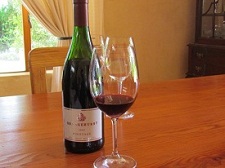By Mika Chall
With only four days to spare at the end of an extended safari in Botswana, Zambia, and Zimbabwe, I opted for my cultural re-entry by way of Cape Town. Spring had just about run its course and with summer on the cusp, the sun was luminous; perfect for exploring the wine country and meandering around this multicultural city that sits under majestic Table Mountain.
Stellenbosch, the second oldest town in South Africa, lies at the heart of its wine industry. The 35-mile trip from Cape Town offers breathtaking scenery at every turn and the area’s Mediterranean climate and amenable soil makes it a perfect location for viticulture.
Our first stop was the Meerlust Estate, with a history that dates back to 1756. Today’s winemaking continues under the guiding hand of Hannes Myburgh, an eighth-generation Myburgh. Their production includes Chardonnay, Pinot Noir, Merlot, Cabernet Sauvignon, and Rubicon. The latter is a creation that was inspired by Nico Myburgh’s (Hannes’s father) desire to create a red equal in style and quality to a Bordeaux. With his 1984 release, he finally achieved his goal. Rubicon debuted to international acclaim.
Tasting Notes
The 2007 Rubicon (74% Cab, 15% Merlot, 11% Cab Franc) is impressive. Intense and full-bodied, the wine has an almost purple hue, the taste of fresh dark fruit, and nicely rounded tannins. It has an ageing potential of 15–20 years, under ideal conditions, and is an excellent accompaniment to fine cheese and game.
A 2003 Pinot Noir is medium bodied, with red fruit, “baking spice,” a hint of earthiness, and well-structured tannins. Another 10 years of cellaring will add greater depth. This Pinot is an attractive complement to red and white meats and grilled fish.
The 2008 Chardonnay, sourced from two vineyards on the estate, was planted in 1991. The result is a full-bodied wine with good acidity. On the palate, there is tropical fruit and balanced minerality. It works with both white and red meat and can be cellared for up to six years.
Our second stop was Grangehurst where I tasted two reds: the 2003 Nikela (37% Pinotage, 34% Cab, 20% Shiraz and 9% Merlot). Pinotage is South Africa’s signature grape. Bred since 1925, it’s a cross between Pinot Noir and a Rhone grape, Cinsault (aka Hermitage). The grape adds smoky, earthy flavors along with hints of tropical fruit. The Nikela is dark ruby, with red berries, mint, cedar, and mocha flavors. Recommended drinking is 6 to 12 years from vintage. The brilliant ’03 reflects its full-bodied maturity which pairs well with lamb shanks, tuna ravioli, and chicken livers. Sign me up!
The second red was the 2003 Pinotage (88% Pinotage, 12% Cab). Deep ruby, the ‘03 has robust tannins, and plummy fruitiness. Recommended drinking is 6 to 12 years from vintage. This Pinotage has great synergy with the bold flavors of gorgonzola, pasta carbonara, and even a big warthog or springbok stew. (Talk to your butcher.)
While I was researching the South African wine scene, I read a New York Times piece about Ntsiki Biyela, a young African winemaker who grew up in a small village in Zululand. Raised by her grandmother in relatively primitive surroundings, her daily chores included fetching water from the river and gathering firewood. Wine was virtually unknown. The story of how, by a quirk of political fate, she received a scholarship to study viticulture and oenology at Stellenbosch University (without knowing a word of Afrikaans) and her rapid rise to the top of her field are nothing short of extraordinary. In 2004, she was hired as winemaker by a boutique winery in Stellenbosch, Stellekaya (home of the stars). Her first red blend won a Gold Medal at South Africa’s Michelangelo Awards. In 2009, she was named South Africa’s Woman Winemaker of the Year. In an industry that has been dominated by white men for more than three centuries, her blends of Merlot, Cab and Pinotage have garnered four-star ratings.
When we arrived at the winery, I thought the tasting would be guided by one of the tasting room staff. Instead, we were treated to charming conversation and a tasting conducted by the winemaker herself. The 2007 Merlot, awarded four stars by John Platter (the Hugh Johnson of South African wine, whose 600-page annual directory of news, reviews, and ratings is considered by most to be South Africa’s most comprehensive wine directory) , is elegant, with tastes of plum and black currant, and soft, full tannins. It would marry well with grilled pork, duck breast, and rack of lamb.
The wine for which Ms. Biyela received the winemaker of the year award is a 2006 Cabernet Sauvignon. This vintage also won the 2008 Silver Veritas and was given a four star rating by John Platter. The wine has a complex structure, is full-bodied with dark fruit, black currants, and tobacco. Pair with a perfectly grilled steak, and the flavors of both the meat and the wine will pop.
Stellekaya’s 2005 Cape Cross is a 2009 Michelangelo Gold Medal winner. This full-bodied Cape blend is 30% Pinotage. It’s succulent on the palate, with sweet plum and chewy tannins. It would make a good match with lamb.
After an hour of tasting and conversation, it was clear that Ms. Biyela, who is now 33 years old, has not let all the adulation affect her personal style. She’s unpretentious and even modest, proud of her wines, and passionate about her profession.





